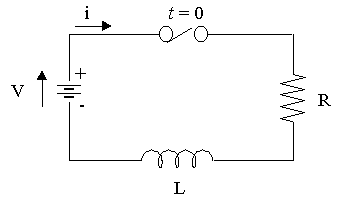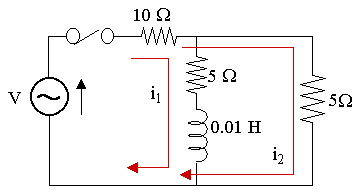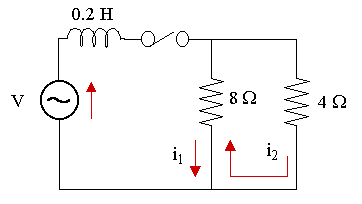http://www.intmath.com/differential-equations/5-rl-circuits.php
Application of Ordinary Differential Equations: Series RL Circuit

RL circuit diagram
The (variable) voltage across the resistor is given by:
The (variable) voltage across the inductor is given by:VR=iR
Kirchhoff's voltage law says that the directed sum of the voltages around a circuit must be zero. This results in the following differential equation:VL=Ldtdi
Once the switch is closed, the current in the circuit is not constant. Instead, it will build up from zero to some steady state.Ri+Ldtdi=V
Solving the DE for a Series RL Circuit
The solution of the differential equation Ri+Ldtdi=V is:i=RV(1−e−(R/L)t)
We start with:
Ri+Ldtdi=VSubtracting Ri from both sides:
Ldtdi=V−RiDivide both sides by L:
dtdi=LV−RiMultiply both sides by dt and divide both by (V - Ri):
V−Ridi=LdtIntegrate (see Integration: Basic Logarithm Form):
∫V−Ridi=∫LdtNow, since i=0 when t=0, we have:
−Rln(V−Ri)=L1t+K
K=−Rln VSubstituting K back into our expression:
−Rln(V−Ri)=L1t−RlnVRearranging:
Rln V−Rln(V−Ri)=L1tMultiplying throughout by -R:
−ln V+ln(V−Ri)=−LRtCollecting the logarithm parts together:
ln(VV−Ri)=−LRtTaking "e to both sides":
VV−Ri=e−(R/L)tSubtracting 1 from both sides:
1−VRi=e−(R/L)t
−VRi=−1+e−(R/L)tMultiplying both sides by −(RV):
i=RV(1−e−(R/L)t)
Please support IntMath!
[We did the same problem but with particular values back in section 2. Separation of Variables]
Here is the graph of this equation:
RV
The Time Constant
The time constant (TC), known as τ, of the functioni=RV(1−e−(R/L)t)is the time at which LR is unity ( = 1). Thus for the RL transient, the time constant is τ=RL seconds.
NOTE: τ is the Greek letter "tau" and is not the same as T or the time variable t, even though it looks very similar.
At 1 τ
1−e−(R/L)t
=1−e−1At this time the current is 63.2% of its final value.
=1−0.368
=0.632
Similarly at 2 τ,
1−e−2=1−0.135=0.865The current is 86.5% of its final value.
After 5 τ the transient is generally regarded as terminated. For convenience, the time constant τ is the unit used to plot the current of the equation
i=RV(1−e−(R/L)t)That is, since τ=RL, we think of it as:
i=RV(1−e−t/τ)
Let's now look at some examples of RL circuits.
Example 1
An RL circuit has an emf of 5 V, a resistance of 50 Ω, an inductance of 1 H, and no initial current.Find the current in the circuit at any time t. Distinguish between the transient and steady-state current.
Example 2
A series RL circuit with R = 50 Ω and L = 10 H has a constant voltage V = 100 V applied at t = 0 by the closing of a switch.Find
(a) the equation for i (you may use the formula rather than DE),
(b) the current at t = 0.5 s
(c) the expressions for VR and VL
(d) the time at which VR = VL



No hay comentarios:
Publicar un comentario